Plerixafor 8HCl (AMD3100 8HCl)
Synonym(s):Plerixafor;1,1′-[1,4-Phenylenebis(methylene)]bis-1,4,8,11-tetraazacyclotetradecane octahydrochloride;1,1?(1,4-Phenylenebis(methylene))-bis-1,4,8,11-tetraazacyclotetradecane, 8HCl, 4H?O, 1,4-bis((1,4,8,11-Tetraazacyclotetradecan-1-yl)methyl)benzene, 8HCl, 4H?O;InSolution
- CAS NO.:155148-31-5
- Empirical Formula: C28H54N8
- Molecular Weight: 502.78
- MDL number: MFCD04974488
- EINECS: 828-184-5
- SAFETY DATA SHEET (SDS)
- Update Date: 2024-11-19 23:02:33
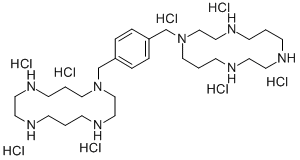
What is Plerixafor 8HCl (AMD3100 8HCl)?
Description
Plerixafor (155148-31-5) is a highly selective CXCR4 antagonist (IC50 = 20-130 nM).1,2 Originally investigated as an HIV replication inhibitor.3 Plerixafor has been investigated for the treatment autoimmune diseases and various cancers.4 Clinically useful for the mobilization of hematopoietic stem cells in the treatment of blood cancers.
The Uses of Plerixafor 8HCl (AMD3100 8HCl)
Plerixafor 8HCl (AMD3100 8HCl) is the hydrochloride of Plerixafor, a chemokine receptor antagonist for CXCR4 and CXCL12-mediated chemotaxis with IC50 of 44 nM and 5.7 nM, respectively - See more at: http://www.selleckchem.com/products/plerixafor-8hcl-db06
The Uses of Plerixafor 8HCl (AMD3100 8HCl)
A specific CXCR4 antagonist.
The Uses of Plerixafor 8HCl (AMD3100 8HCl)
Plerixafor Hydrochloride (1:8), is an immunostimulant used to mobilize hematopoietic stem cells in cancer patients. It is a hematopoietic stem cell (HSC) mobilizer that inhibits the CXCR4 chemokine receptor and blocks binding of its ligand, stromal cell-derived factor-1-α (SDF-1-α).
What are the applications of Application
AMD3100 octahydrochloride is a specific CXCR4 antagonist
General Description
A symmetrical bicyclam compound that antagonizes CXCL12 (SDF1) binding to CXCR4 (IC50 = 108 and 245 nM using rat and human CXCR4, respectively) and inhibits SDF1-induced Ca2+ flux (by 100% at 100 ng/ml in SUP-T1 and THP-1 cultures) as well as CXCR4-, but not CCR5-, mediated HIV infection (IC50 ≤200 nM), while enhancing the binding of SDF1 to CXCR7 (by ~60% at 1 mM with CXCR7-expressing HEK293T cells) and SDF1-induced β-arrestin recruitment to CXCR7 (EC50 = 6.48 and 11.8 nM, in the presence and absence of 10 μM AMD3100, respectively). Administration AMD3100 via intravenous infusion is also reported to result in hematopoietic stem cell mobilization in humans, dogs, and mice in vivo. Exhibits no inhibitory effects against chemokine-induced signaling via CXCR1/2/3 or CCR1/2/3/4/5/6/7/8/9.
Biological Activity
Highly selective CXCR4 chemokine receptor antagonist (IC 50 values are 0.02 - 0.13 and > 25 μ M for CXCR4 and all other chemokine receptors respectively). Switches inflammatory responses from Th2 to Th1 type and reduces airway hyperresponsiveness in a mouse model of asthma. Potently inhibits HIV-1 and HIV-2 replication in vitro (EC 50 = 4 - 35 nM) and mobilizes hematopoietic stem cells in vivo .
Biochem/physiol Actions
Cell permeable: yes
Clinical Use
Plerixafor hydrochloride, a chemokine CXCR4 (SDF-1) antagonist, was launched by Genzyme for the treatment of enhancing mobilization of hematopoietic stem cells for autologous transplantation in patients with lymphoma and enhancing mobilization of hematopoietic stem cells for transplantation in patients with multiple myeloma. Being a CXCR4 antagonist, a specific cellular chemokine receptor, plerixafor triggers the rapid movement of stem cells out of the bone marrow and into circulating blood where the stem cells can be collected for use in stem cell transplants. Regarding its use for cardiac applications, some clinical data suggests that the presence of stem cells circulating in the bloodstream or directly injected into the hearts of patients who have suffered a heart attack may result in improved cardiac function.
Synthesis
A concise one-pot synthesis was achieved by a rather novel nitrogen protecting strategy. Tetraazacyclotetradecane 88 was protected as its phosphorotriamide 89 by reaction with POCl3 and Et3N in hot DMF. Without isolation, compound 89 was bis-alkylated with dibromide 90 in the presence of sodium carbonate in refluxing DMF overnight to give bis-phosphoramide 91. The crude dimeric bis-phosphoramide was hydrolyzed with 3 M HCl to afford plerixafor hydrochloride (XV) in 62¨C68% yield.
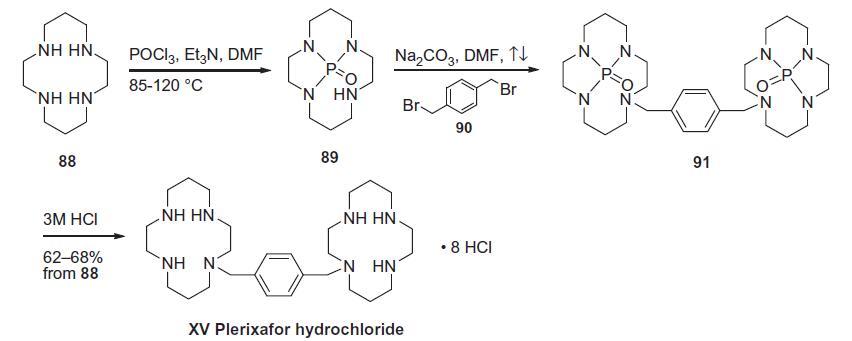
storage
-20°C (desiccate)
References
1) Donzella, et al. (1998), AMD3100, A Small Molecule Inhibitor of HIV-1 Entry via the CXCR4 Co-Receptor; Nat. Med. 4 72 2) Hatse et al. (2002), Chemokine Receptor Inhibition by AMD3100 Is Strictly Confined to CXCR4; FEBS Lett. 527 255 3) Bridger et al. (1995), Synthesis and Structure-Activity Relationships of Phenylenebis(methylene)-linked Bis-Tetraazamacrocycles That Inhibit HIV Replication. Effects of Macrocyclic Ring Size and Substituents on the aromatic Linker; J. Med. Chem. 38 366 4) Wang et al. (2020), CXCR4 antagonist AMD3100 (plerixafor): from an impurity to a therapeutic agent; Pharmacol. Res. 159 105010
Properties of Plerixafor 8HCl (AMD3100 8HCl)
| Melting point: | 188 - 193°C (dec.) |
| storage temp. | Sealed in dry,Store in freezer, under -20°C |
| solubility | H2O: ≥10 mg/mL, clear |
| form | solid |
| color | White |
| Water Solubility | Soluble in water (100mM) |
| Stability: | Stable for 1 year from date of purchase as supplied. Solutions in distilled water may be stored at -20°C for up to 2 months. |
Safety information for Plerixafor 8HCl (AMD3100 8HCl)
| Signal word | Danger |
| Pictogram(s) |
 Flame Flammables GHS02  Corrosion Corrosives GHS05 |
| GHS Hazard Statements |
H226:Flammable liquids H314:Skin corrosion/irritation |
| Precautionary Statement Codes |
P210:Keep away from heat/sparks/open flames/hot surfaces. — No smoking. P233:Keep container tightly closed. P240:Ground/bond container and receiving equipment. P241:Use explosion-proof electrical/ventilating/lighting/…/equipment. P242:Use only non-sparking tools. P243:Take precautionary measures against static discharge. P264:Wash hands thoroughly after handling. P264:Wash skin thouroughly after handling. P280:Wear protective gloves/protective clothing/eye protection/face protection. P363:Wash contaminated clothing before reuse. P301+P330+P331:IF SWALLOWED: Rinse mouth. Do NOT induce vomiting. P303+P361+P353:IF ON SKIN (or hair): Remove/Take off Immediately all contaminated clothing. Rinse SKIN with water/shower. P370+P378:In case of fire: Use … for extinction. P405:Store locked up. P403+P235:Store in a well-ventilated place. Keep cool. |
Computed Descriptors for Plerixafor 8HCl (AMD3100 8HCl)
New Products
(S)-3-Aminobutanenitrile hydrochloride 4-Methylphenylacetic acid N-Boc-D-alaninol N-BOC-D/L-ALANINOL Tert-butyl bis(2-chloroethyl)carbamate 3-Morpholino-1-(4-nitrophenyl)-5,6-dihydropyridin- 2(1H)-one Furan-2,5-Dicarboxylic Acid Tropic acid 1-Bromo-3,5-Di-Tert-Butylbenzene S-2-CHLORO PROPIONIC ACID ETHYL ISOCYANOACETATE 2-Bromo-1,3-Bis(Dimethylamino)Trimethinium Hexafluorophosphate 4-IODO BENZOIC ACID 3-NITRO-2-METHYL ANILINE 1-(2,4-DICHLOROPHENYL) ETHANAMINE (2-Hydroxyphenyl)acetonitrile 4-Bromopyrazole 2-(Cyanocyclohexyl)acetic acid 4-methoxy-3,5-dinitropyridine 1-(4-(aminomethyl)benzyl)urea hydrochloride 2-aminopropyl benzoate hydrochloride diethyl 2-(2-((tertbutoxycarbonyl)amino) ethyl)malonate tert-butyl 4- (ureidomethyl)benzylcarbamate Ethyl-2-chloro((4-methoxyphenyl)hydrazono)acetateRelated products of tetrahydrofuran
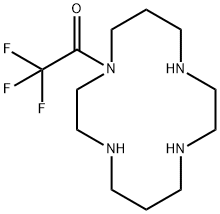
![1,4,8,11-Tetrakis[(4-methylphenyl)sulfonyl]-1,4,8,11-tetraazacyclotetradecane](https://img.chemicalbook.in/CAS2/GIF/71089-74-2.gif)
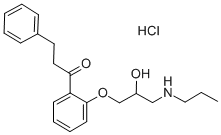
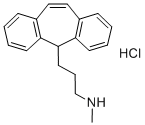
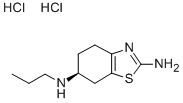



You may like
-
 Plerixafor octahydrochloride 98% (HPLC) CAS 155148-31-5View Details
Plerixafor octahydrochloride 98% (HPLC) CAS 155148-31-5View Details
155148-31-5 -
 AMD3100 octahydrochloride hydrate CAS 155148-31-5View Details
AMD3100 octahydrochloride hydrate CAS 155148-31-5View Details
155148-31-5 -
 CXCR4 Antagonist I, AMD3100 CAS 155148-31-5View Details
CXCR4 Antagonist I, AMD3100 CAS 155148-31-5View Details
155148-31-5 -
 AMD3100 CAS 155148-31-5View Details
AMD3100 CAS 155148-31-5View Details
155148-31-5 -
 1975-50-4 98%View Details
1975-50-4 98%View Details
1975-50-4 -
 2-HYDROXY BENZYL ALCOHOL 98%View Details
2-HYDROXY BENZYL ALCOHOL 98%View Details
90-01-7 -
 14714-50-2 (2-Hydroxyphenyl)acetonitrile 98+View Details
14714-50-2 (2-Hydroxyphenyl)acetonitrile 98+View Details
14714-50-2 -
 118753-70-1 98+View Details
118753-70-1 98+View Details
118753-70-1